Interview with Peter Tepe | Section: Interviews
Abstract: In his second w/k interview, Roland Regner begins by explaining the concept of his Arché work cycle and the series that it consists of. He goes on to talk about the work processes used in three of these series. The transformations create abstract images from the colour information of the original photograph, whereby an objective criteria is used to decide when the transformation is complete. Further topics of discussion are: the cooperation with scientists and technicians, the “content before aesthetics” principle, the selection process of photos for an exhibition, mistaking the transformed photos for paintings, current projects and future plans. In the appendix, Regner answers questions that arose in the context of the peer review.
Roland Regner, the interview Roland Regner: Transformations was published in w/k in 2019. The conversation centred on your radical project in which you expose biographical photographs to a certain bacterium. This transforms the photographs in such a way that they turn into abstract images, but recipients can still recognise the now formerly biographical photographs based on a listing in the photo titles of the key visual elements present in each picture. You have been collaborating with the Microbiological Institute of the University of Zurich on this project. In 2022, we now turn to other series within your Arché cycle of works, which are also being transformed.
Timeline and concept of the cycle
First of all, looking at the chronology: when did you start this cycle? What time frame have you followed so far, and what time schedule is planned for the cycle going forward?
I started in 2012 while I was doing my Master’s degree at the Zurich University of the Arts. First of all, I had to take all biographical pictures of me that I had, meaning all the photos in which I can be seen, and sort through them. This then resulted in me creating several Series, because my photo archive contains different substrates: slides/negatives, photographic prints, X-ray images and digital photographs.
There was a huge amount to transform in the first few years. I took a break of one or two years in-between. So, I’m not working continuously on this project. What I do is, I collect images over a period of time and then transform them. At the moment, I’m busy transforming the massive number of digital photographs I have. But I often also come across individual analogue images, such as slides/negatives and photo prints, which I then transform too. The whole thing is a constant process that will never really come to an end.
Could you please outline the concept of the entire Arché cycle? What is it about?
I am transforming my entire archive of personal photographs. This means that I subject all the slides, negatives, digital photographs, X-rays and photographic prints that show me in different situations in life to processes specially designed for the individual picture media. With the image carriers, the information created in the various storage media is also transformed – the information layer changes while the picture material remains the same. It is precisely this level of visual encoding which characterises the promise of truth of photographs. As described in detail in Transformations, the slides or negatives are infected with an intestinal bacterium from the Shewanella division, and thereby transformed.
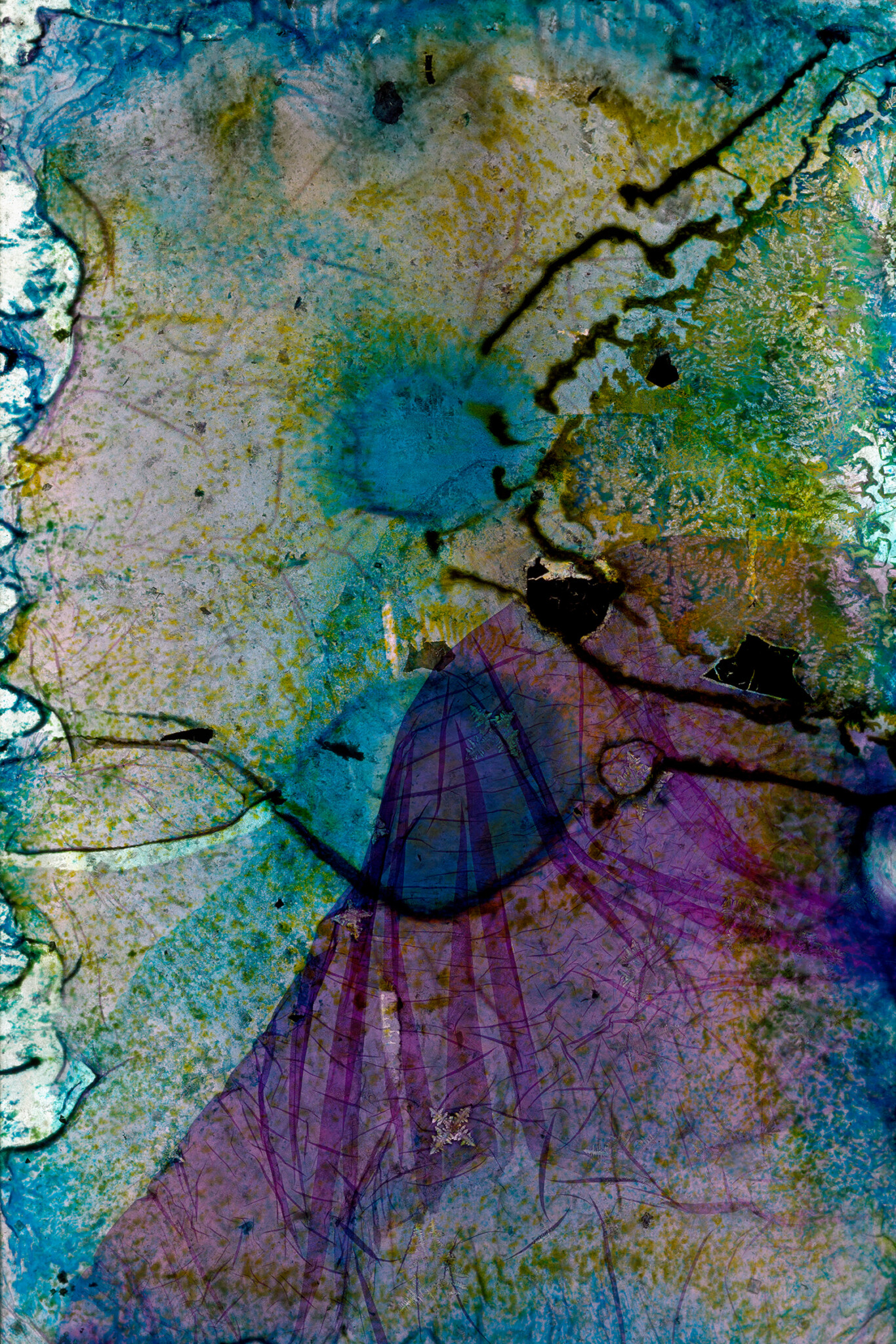
Two series as examples
Our discussion won’t allow us to refer to all the other series from the Arché cycle of works, so would you please select three that we can talk about as examples?

We can start with the photo prints, then move on to the digital photographs and finally look at the X-rays.
Regarding the Photo prints series, how do you tackle a particular photo? Which different work steps are involved?
For the photo prints, I use sodium hydroxide, or caustic soda, which is a chemical substance. Caustic soda has a pH value between 8 and 14, depending on the ratio in which NaOH and water are mixed. Only a specific pH value (not too corrosive) led to the result I wanted.
The prints are then placed individually in containers of caustic soda. Almost every day I have to check and sort out the prints in the containers. If the original image information is no longer recognisable, the transformation process is halted and the final result of the transformation is dried. Unlike for example with slides or negatives, with photographic prints the transformed colour layer is extremely fragile and very sensitive once the process is finished.
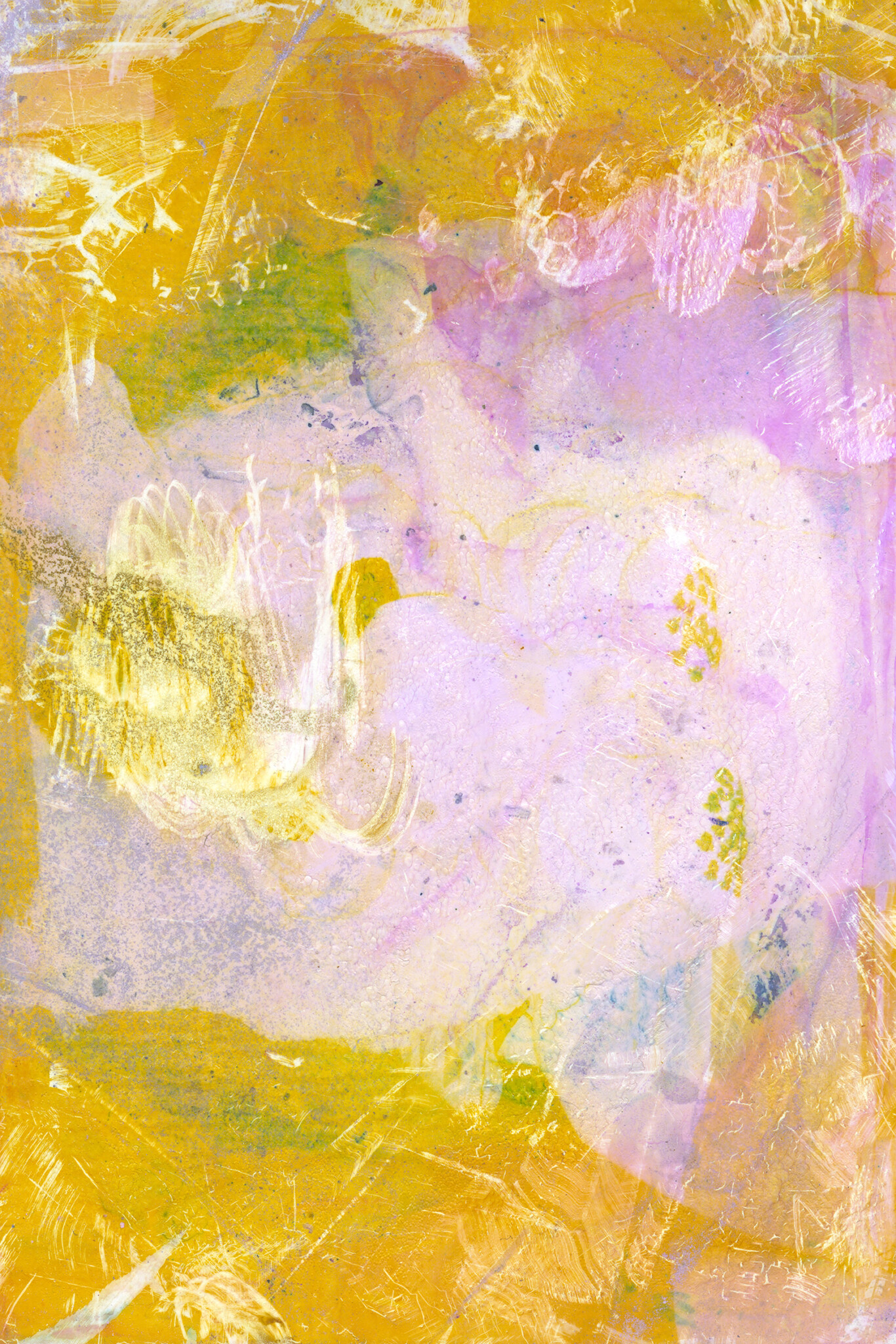
And which work steps are involved for the Digital photographs series?
For the transformation of the digital photographs, I got together with interaction designers as well as computer scientists and programmers to have a special computer virus programme written. This runs autonomously using chaotic algorithms. To do this, I had to buy a high-performance computer with a large memory and two very powerful graphics cards. These components are important, as they ensure that the programme runs in real time and that I am able to stop the transformation process directly once the image content is no longer recognisable. Various different transformation algorithms are activated by random generators. The trigger for this is an extra music programme, into which you can load sounds. The user interface of the programme is pretty simple. The photo is loaded and the music programme started. A window then opens that shows the transformation process as described in real time. And of course there is a stop button. As soon as I press this button, the original image is overwritten, and the transformed photo is left. Like with the other series, the process is irreversible, and the outcome unpredictable.
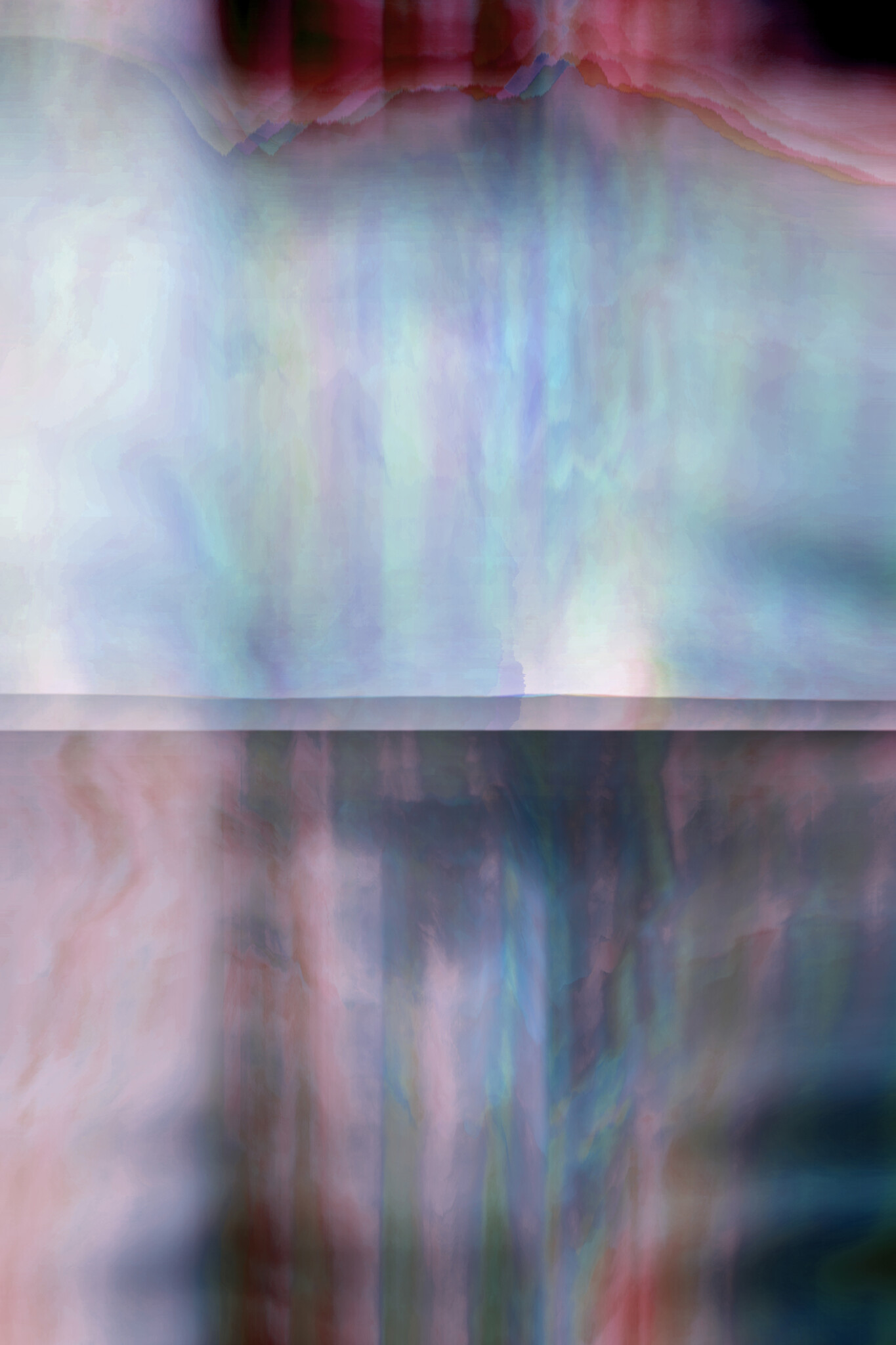
We should also briefly mention your X-ray images series.
In the beginning I talked a lot to X-ray film developers. They gave me the idea of transforming the X-ray images using intensive UV and red light irradiation. This process is the longest one, taking two months on average, needing almost daily irradiation lasting eight hours.

All of the series in the cycle of works require a process of monitoring and sorting through the images. Do you stop the transformation process as soon as “the original image information is no longer recognisable”? Or do you intuitively decide in line with aesthetic criteria whether the print can remain as it is?
I stop the process when the original image information is no longer recognisable. Making decisions intuitively based on aesthetic criteria would be difficult to carry out in this work: I would have to anticipate whether the momentary aesthetic status of the image is still more attractive or not. If I wait for a possibly better result, the image might completely dissolve and disappear.
You determine, then, whether the transformation of a biographical photograph is complete according to an objective criterion: it is always deemed as completed or the new image is finished “when the original image information is no longer recognisable”. Aesthetic criteria play no role in that.
That’s correct.
Do you apply this objective criterion to all series in the Arché cycle?
Yes.
The role of colours
The transformation process generally features two aspects: firstly, the biographical image information is transformed in such a way that Roland Regner is no longer recognisable as himself at whatever age in differing settings. Secondly, the colour information of the original photo is retained: during the process of transformation, the colours are mixed anew in an unpredictable way. An abstract image emerges that has an aesthetic appeal, to a greater or lesser degree.
That’s right. The material of the various image media remains in its original state, only the information layer contained on the medium is transformed. The colour information on the medium layer of the transformed images is therefore still present, just arranged differently and/or more chaotically.
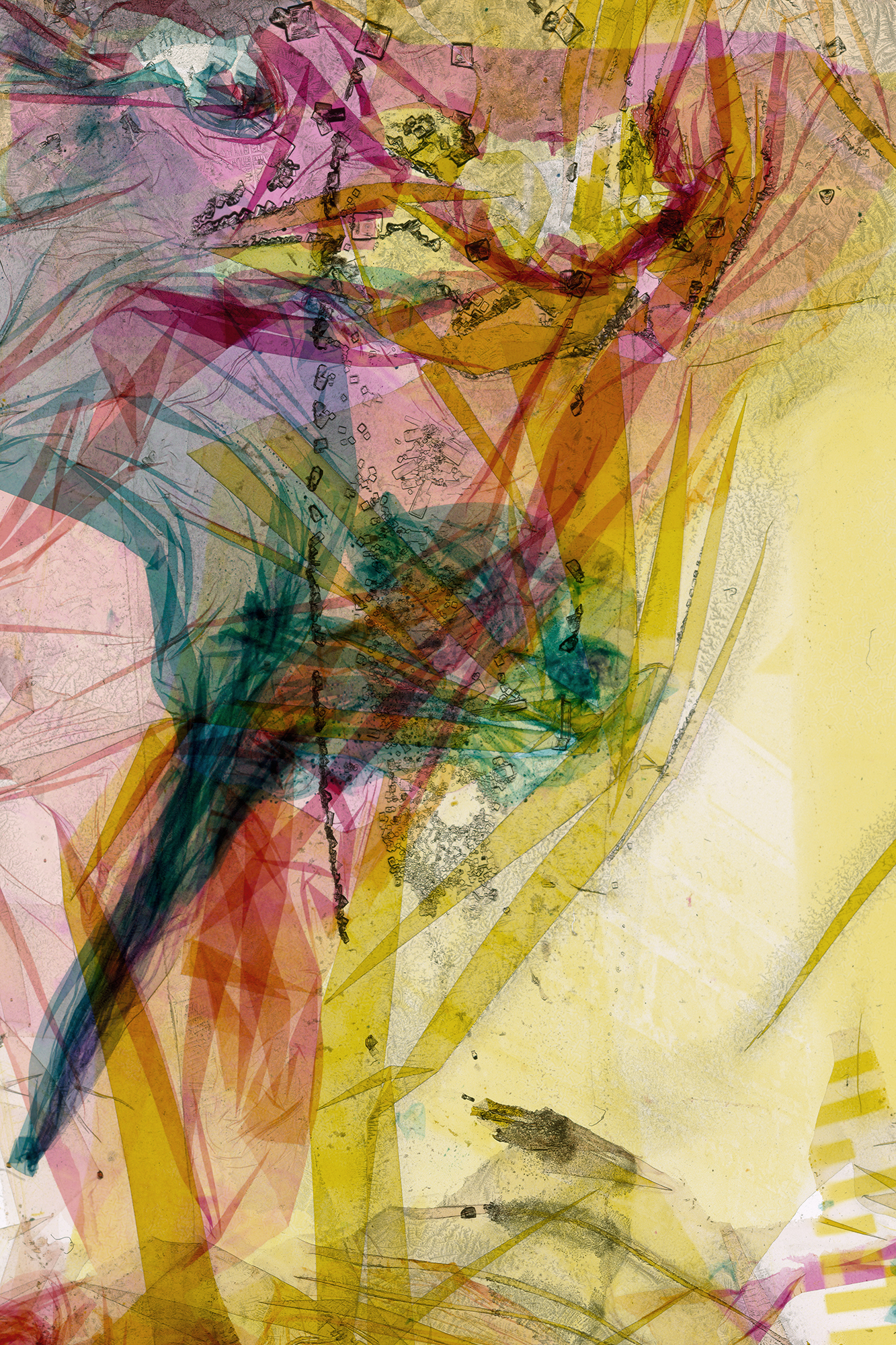
If the artistic concept involves combining the significant transformation of the biographical image information with the creation of an abstract coloured image from the colour information, the obvious question is how you achieve the latter in the various series.
I am not able to describe in detail exactly how the colours of the individual series are created. With the photographic prints, it is the chemical reaction of the caustic soda with the chemical composition of the respective print. With the slides/negatives, it is the bacterial reaction with the colour layer, and with the digital photographs it is the random generators and algorithms. The main challenge, however, is to convert the colour or information layer of the individual image carriers, but not to destroy the carrier material in the process. In the case of the photographic prints, this is done by determining a certain pH value of the caustic soda as already described above, and for the slides/negatives by determining the correct concentration of the bacterium in the nutrient fluid. With the digital photographs, it’s a matter of preserving the readability of the file, making sure that it is not permanently damaged after transformation and so can still be recognised and opened by programmes.
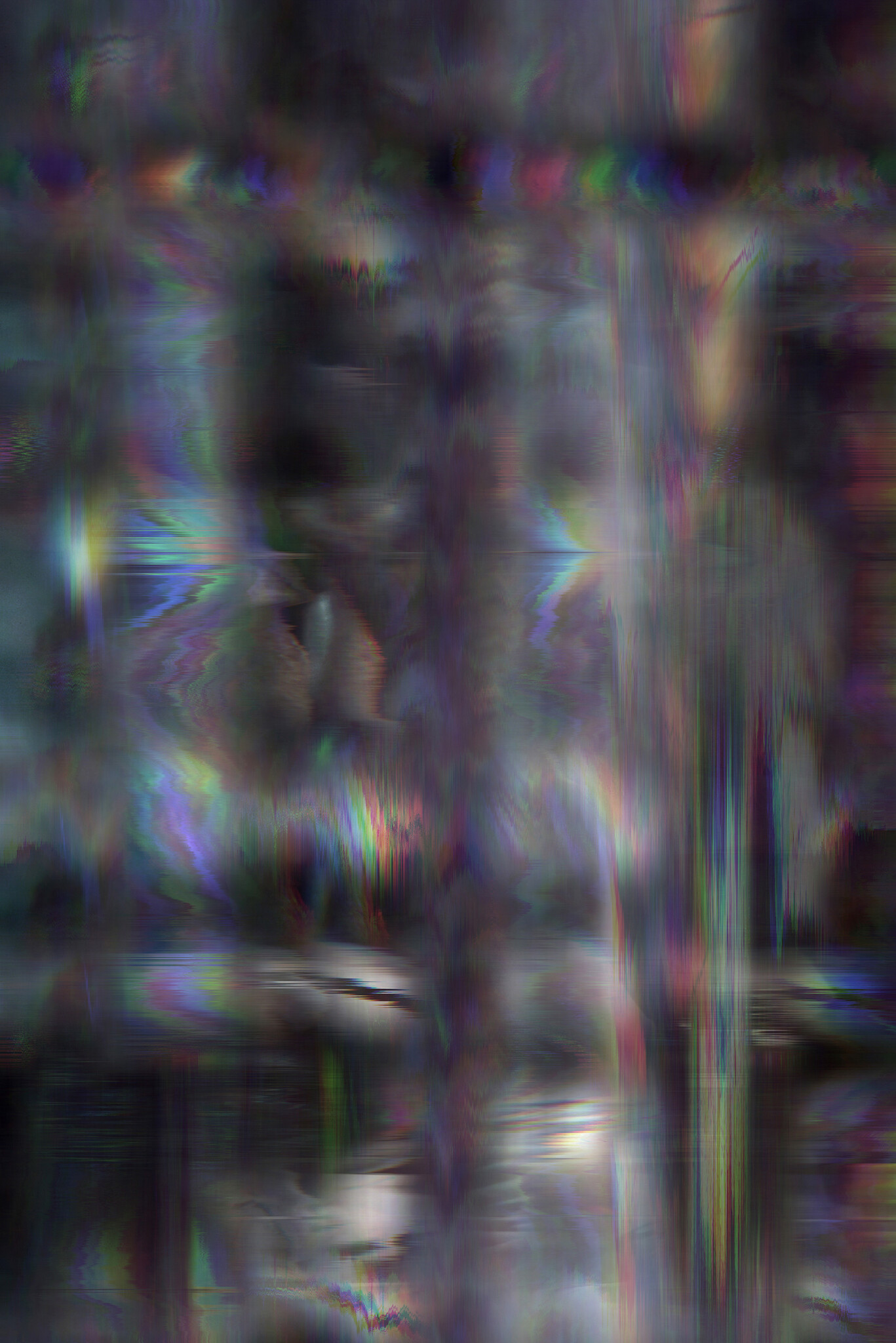
Now let’s turn to your collaboration in the selected series with experts from the science and technology fields: What precisely was achieved through these collaborative partnerships that would not have been possible without them?
I was always pretty reliant on the help of experts and professionals. I could never have produced the computer virus programme with all the random generators myself, for example. Nor would I have been able to experiment to find the right bacterium in the right concentration for converting the slides/negatives. Also finding out how caustic the sodium hydroxide must be in order not to completely destroy the photo prints. With the X-rays, I’d have had no idea how to transform them without help from the experts. It was only by talking with them directly and experimenting that made it possible. The Microbiology Institute at the University of Zurich even allowed me to work for almost two years continuously to transform the first large quantity of slides/negatives. I not only got support from the researchers and technicians, but also had many interesting conversations and debates about the project.
What was actually talked about in these discussions?
I was asked quite a few questions, for example why I was undertaking such a radical project in the first place, what it means for me and my family if there are no pictorial records of me left. These personal questions have led to lengthy discussions about what a photographic image actually is, or can be. Questions here included: How fragile is this information and memory layer in reality? What do we ourselves project into it? What does remembering mean in general? Is remembering via images a process that is learned culturally and socially?
These discussions were often exciting ones, and sometimes resulted in a certain incomprehension on both sides. But I found them highly productive for both sides too.
Content before aesthetics
Changing subject now: let’s say you choose 10 from 100 transformed biographical photos for an exhibition. All 100 pictures fulfil the objective criterion, that there is nothing left of Roland Regner and his surroundings in the pictures. Don’t aesthetic criteria now automatically come into the equation, in the sense that you like picture a better than picture b, that you find it more attractive, aesthetically more accomplished, and for that reason select it for the exhibition?
So far, I have talked about the process of working on the image medium. Now you’re introducing the question of how works are selected for an exhibition. Other criteria play a role in this first: What references do I want to make between the images chosen? Should there be a narrative, and if so, what should it be? What is the aim of the exhibition? What type of exhibition space is it? Which works by other artists are also in the room?
So first of all, the content has to be considered. That is why it is so important that the titles of the pictures should contain a maximum of six of the most important image contents. Once I’ve chosen the images, I look to see which of them work well together in terms of form and aesthetics, if the selection aligns with the idea I am pursuing in terms of content: so it’s content before aesthetics. It would weaken the conceptual and media-reflective approach of the work if I opted for one image or another just on the basis of aesthetic criteria.
I would like to know more about the “content before aesthetics” principle. For an exhibition, you select the transformed photos based on a content idea. Can I ask you to illustrate this using an example and also to clarify what role the titles of the pictures play in this case.
To do this, I will choose two works from the Photo prints series.
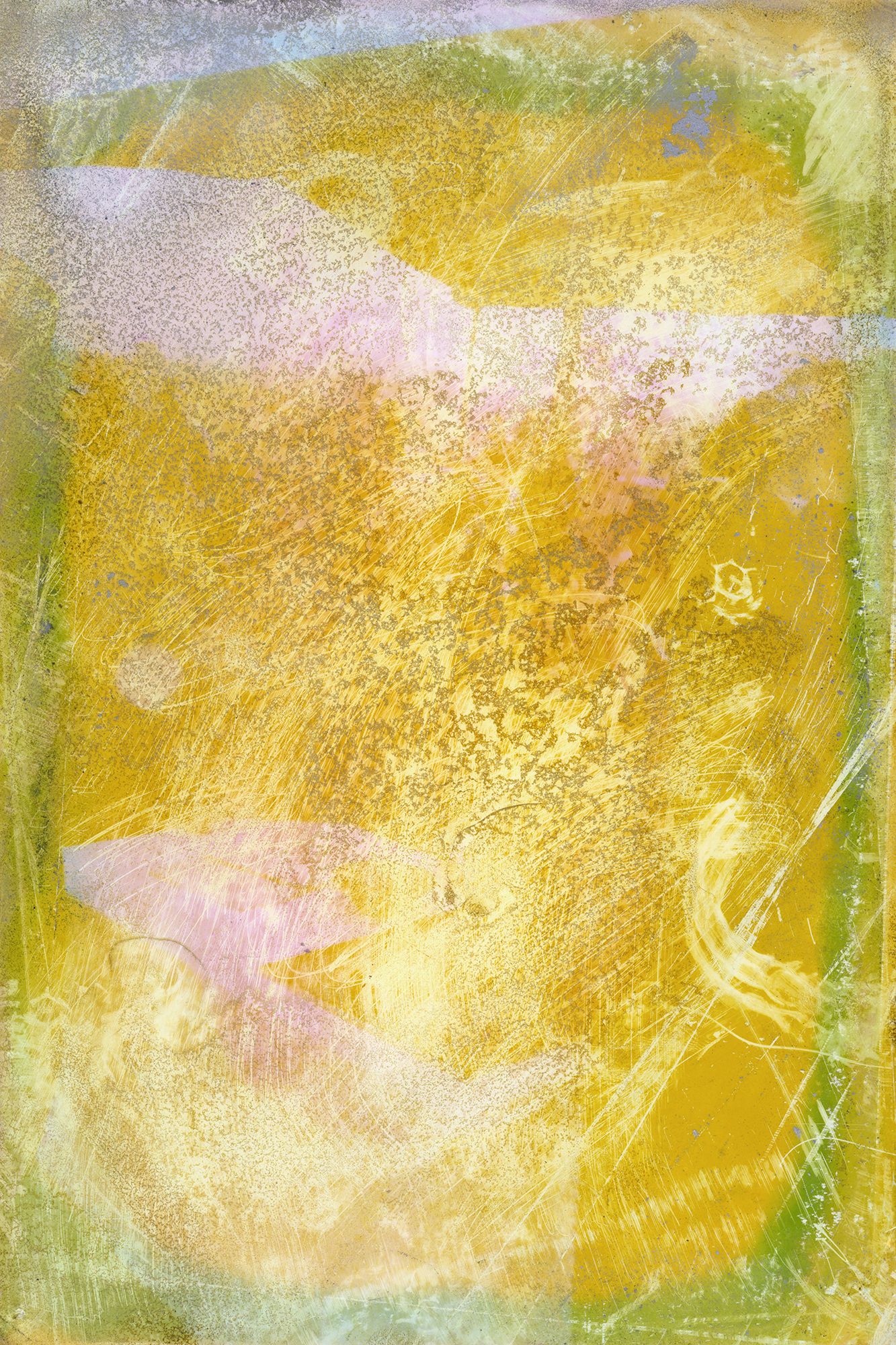

The important factor behind the pictures I select is what was previously depicted in the pictures. The two pictures I’ve selected originally showed me as a 5-year-old and then as an 18-year-old at a Christmas party.
So, for the exhibition, you therefore select transformations of photos whose original setting or subject are related to each other, e.g. Christmas photos that show you next to a Christmas tree and presents. To ensure that these subject references, which are no longer recognisable in the transformed photos, are not forgotten, you give each transformed photo a relevant title that is based on a certain formula.
But the selected images don’t always necessarily have to share the same motif in order to be placed in relation to each other. What is actually important here, as I said before, is which content-related references I want to make between the selected pictures at an exhibition. I have worked out a system for the titles, which gives the transformed photos chronologically ordered serial numbers on the one hand, and also assigns a maximum of six terms and the year to each photo. This is my attempt at recording the most important previous contents of the pictures.
So the principle of “content before aesthetics” means that, for example, the two transformed photos shown are selected for an exhibition on the basis of the original subject references you just outlined. Aesthetic preferences can, however, be added into the process of selection if, for example, five pictures are suitable in terms of content, but there is only room for two of them in the exhibition.
That’s correct.
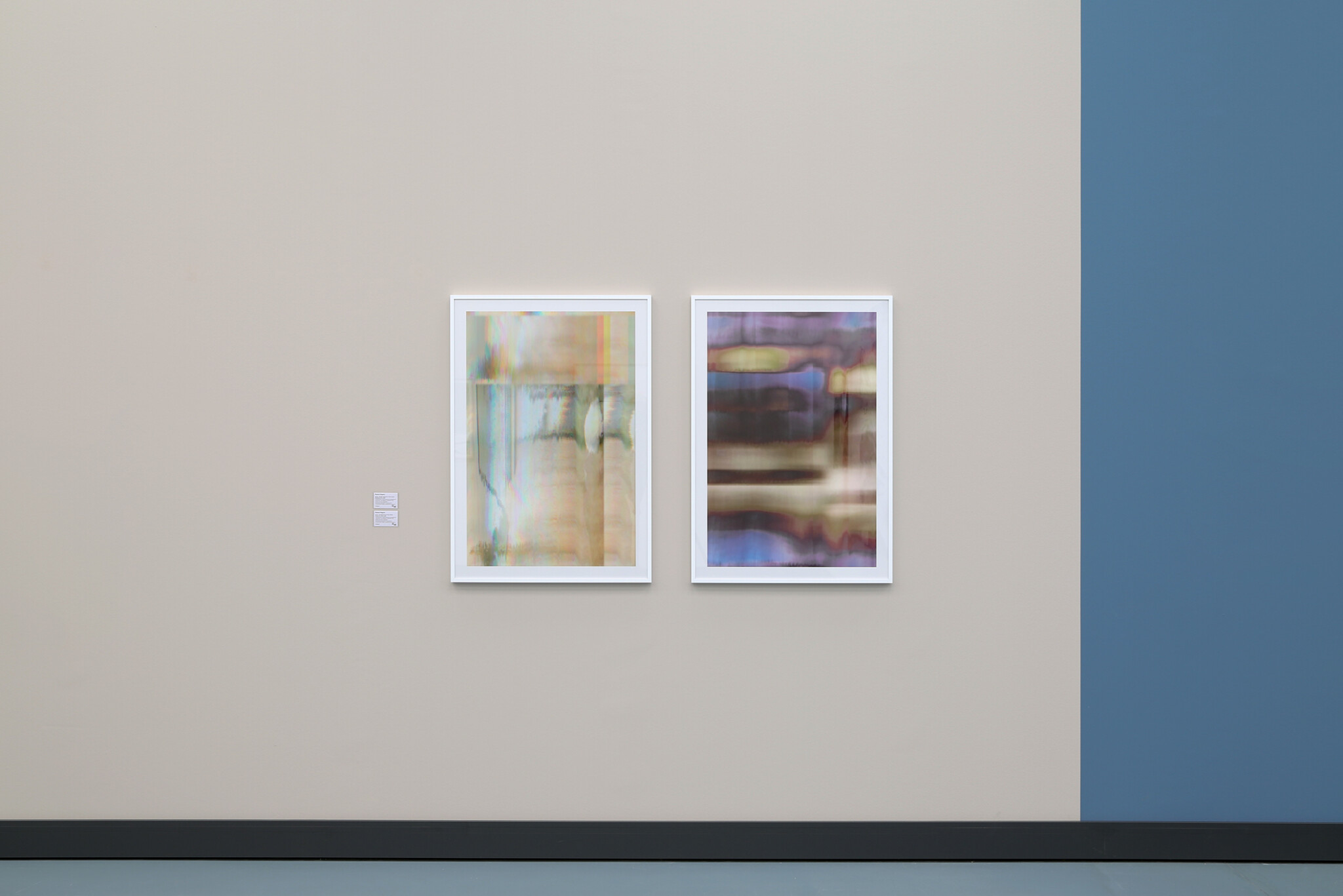

Viewed in isolation, the transformed photographs are strongly reminiscent of works of 20th century informal painting, or, put more generally, of abstract visual art. But if the principle of “content before aesthetics” applies, then this view of the transformed photos does in some respects represent a misunderstanding.
The aesthetics of the new biographical photos did trouble me in the beginning. Or to be more precise, the aesthetic proximity to painting that you also describe. It was the case that people at exhibitions did at first believe the pictures were paintings. They had to look again to see that photography was the medium used. When you look at the pictures more closely, you do see that they are photographic prints. The first part of each title refers to the original photographic image material: slides/negatives, photographic prints, X-rays and digital photographs. The listed image contents then also help to provide clues as to what was previously recognisable in the image. Usually, the exhibitions also present a text with a technical description of what I have done with my biographical photos.
What do you want to achieve with the combination of Transformed photos plus system-based titles in terms of the people viewing the pictures?
What I ultimately want is for viewers themselves to put together a picture in their heads based on my biographical photos/pictures/memories and the title. Understanding photographic images is primarily a process of responding. Whether this succeeds or not, or whether the viewer allows themselves to buy into this, is up to them.
The work shows the role of the photographic image as a personal archive medium and the linked promise of truth, meaning that the biographical photo is a reflection of reality. I use documents from my past to show people viewing the pictures how fragile the materiality of photographic image media is and how easy it is to disturb those image surfaces on which we try to preserve situations that existed in the past. I refer to the fact that someone viewing photographs always has to perform an act of abstraction, a detachment from the materiality of various image media, in order to allow the past to actually appear at all within what is being seen. The question arises as to what remains when you undo that historically constructed attribution that photographs can transfer the real to the level of the medial.
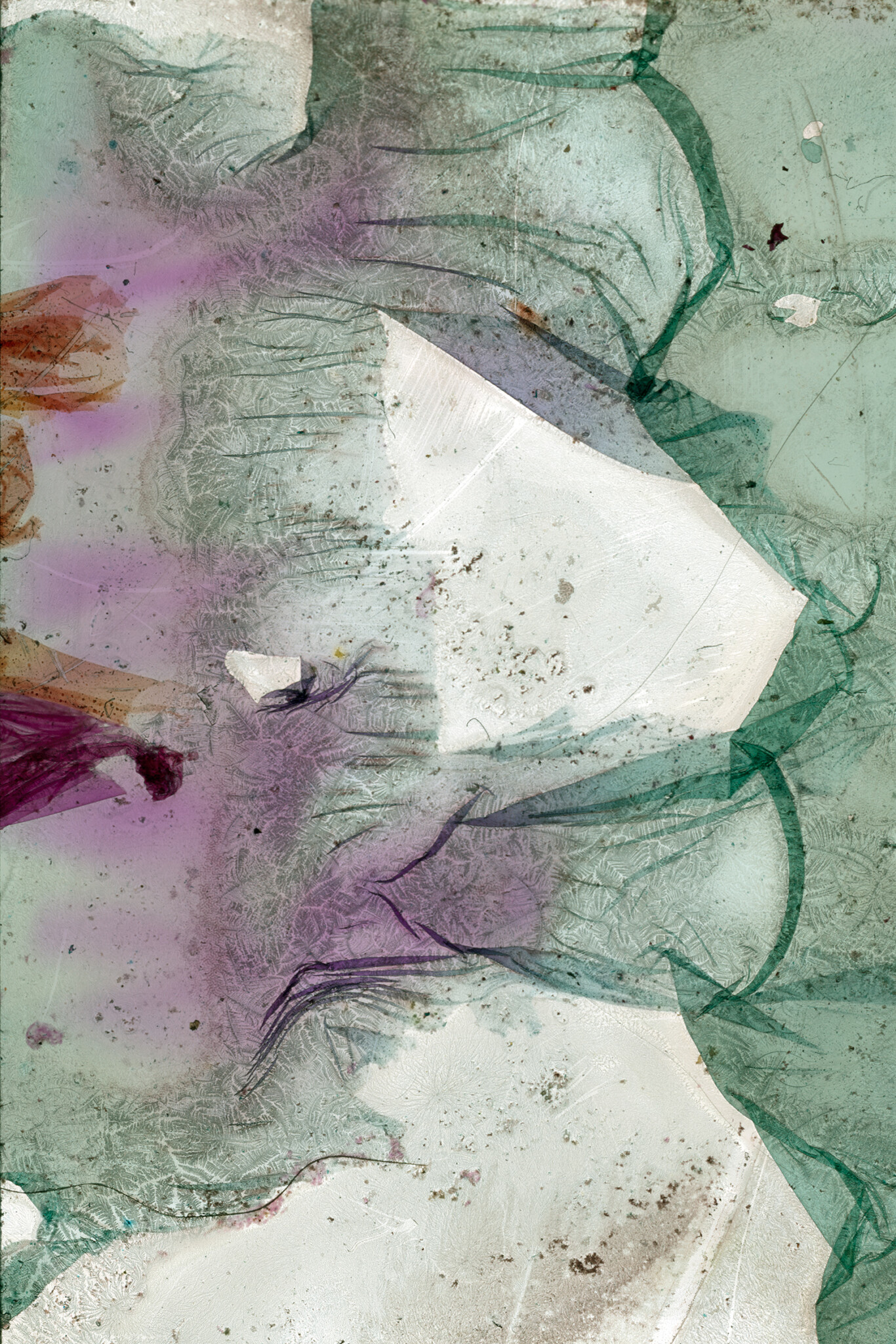
Outlook
What are you currently working on and what do you have planned for the near future?
I am currently working on several other projects. These also have a strongly media-reflective approach. Related to the Arché cycle of works, the main theme is the transformation of the digital photographs. The computer virus programme was developed two years ago, and a lot of digital images have accumulated in the time since which now all have to be converted. When I’m not working on the actual transformation process, I’m continually collecting biographical images so that I can transform them later. Since the cycle of works is a life project, work on it never stops. Adaptations to existing transformation processes or new ones also have to be developed all the time. This is dependent on how the medium of photography and especially the materiality of the photographic image will develop in the future. As the work now comprises a large number of images, a larger book project is also planned – a kind of encyclopaedia consisting of several books and which can be added to on a regular basis.
I will soon have to make a will for when I die. Since I probably won’t manage to transform all my biographical images before my death, a precise instruction is required in this respect so that the last images of mine can then also be transformed posthumously.
Roland Regner, thank you for the interview and for giving us a greater understanding of your major project.
Details of the cover photo: Roland Regner: Arché. Film still from the video portrait: Roland Regner – photographer and artist. (2022)
Links to the video:
YouTube: https://www.youtube.com/watch?v=bz5lmH2a4hU
Instagram: https://www.instagram.com/tv/Cd0VW4HAg3o/
Facebook: https://fb.watch/da-INreF6U/
Blog: http://blog.qah.koeln/2022/05/14/roland-regner-fotograf-und-kuenstler/
Questions from the reviewer
Some additional questions arose during the peer review. Usually in w/k, we integrate these proposed new questions and answers into the interview – but in this case it seems more appropriate to add them as the appendix.
How can the results of these transformations – the biological and bacterial, chemical, digital – actually be classified? It’s hard to call it photography, that seems to make no sense to me much beyond the fact that we have a dark chamber, a suitably small aperture and a light-sensitive layer. Even the term “extended photography”, still common decades ago, cannot really be applied here now.
Classification is one of the jobs of art historical discourse, which is concerned with embedding and locating artistic works. This has little to do with what I do as an artist, so I leave that to the art historians.
For me, it is still a photographic image. The colour information on the medium layer of the transformed images is still there, it’s just arranged differently and/or in a more chaotic way.
What kind of artefact is the viewer confronted with?
A transformed biographical photo.
Does the viewer – is the viewer allowed to – distinguish between what they see as successful and less successful pictures?
For me, there are no pictures that have come out as “less successful”. Instead, the conceptual idea of the entire project is paramount. The viewer, on the other hand, will no doubt find certain pictures more aesthetically pleasing than others, or will be able to find a way into some of them more easily.
Does it change the viewers’ perception of the images if they read the captions?
Yes, I have experienced that at exhibitions. Once the viewer knows that it is a biographical photo, they look at the image differently and seek references in themselves and in the image. They are to some extent turned back on themselves. The title of the picture is a kind of connecting point. What I ultimately want is for viewers themselves to put together a picture in their heads based on my biographical photos/pictures/memories and the title.
Wouldn’t a simple 1, 2, etc. numbering system achieve the same thing?
No. There are the different series (slides/negatives, photographic prints, X-rays and digital photographs) within the cycle of works, each with a different materiality. I wanted to differentiate this material basis of the individual media from each other. The itemisation of the maximum of six most important elements of the picture plus the year is important for an attempt to encode or decode the picture, as already mentioned.
Won’t the biographical reference, place, time, etc., become completely obsolete?
In terms of myself, time will tell. There are important pictures for me that have not lost their meaning even after they have been transformed, so they still have a strong connection to my life.
If we take the picture of my first day at school, for example, it is still very much present in my mind. I am standing in front of a staircase. In the background is the school and a blackboard with the year I started school on it. I’m dressed in light blue Puma sneakers and short yellow trousers, holding my school bag. I also know there’s a tree … but I can’t remember if it’s to my left or right.
But of course the work also raises the question of what exactly the photograph could be, going beyond classical classifications, in this case as biographical images.
We might understand the above example of an image as a kind of pictorial process of breaking away from our own biography. We are now forced back onto ourselves, our own past and our own memory. This could represent a certain liberation from the power of photographic images.
English translation by Ian McGarry Translation & Language Services
How to cite this article
Peter Tepe (2022): Roland Regner: Arché. w/k–Between Science & Art Journal. https://doi.org/10.55597/e8454
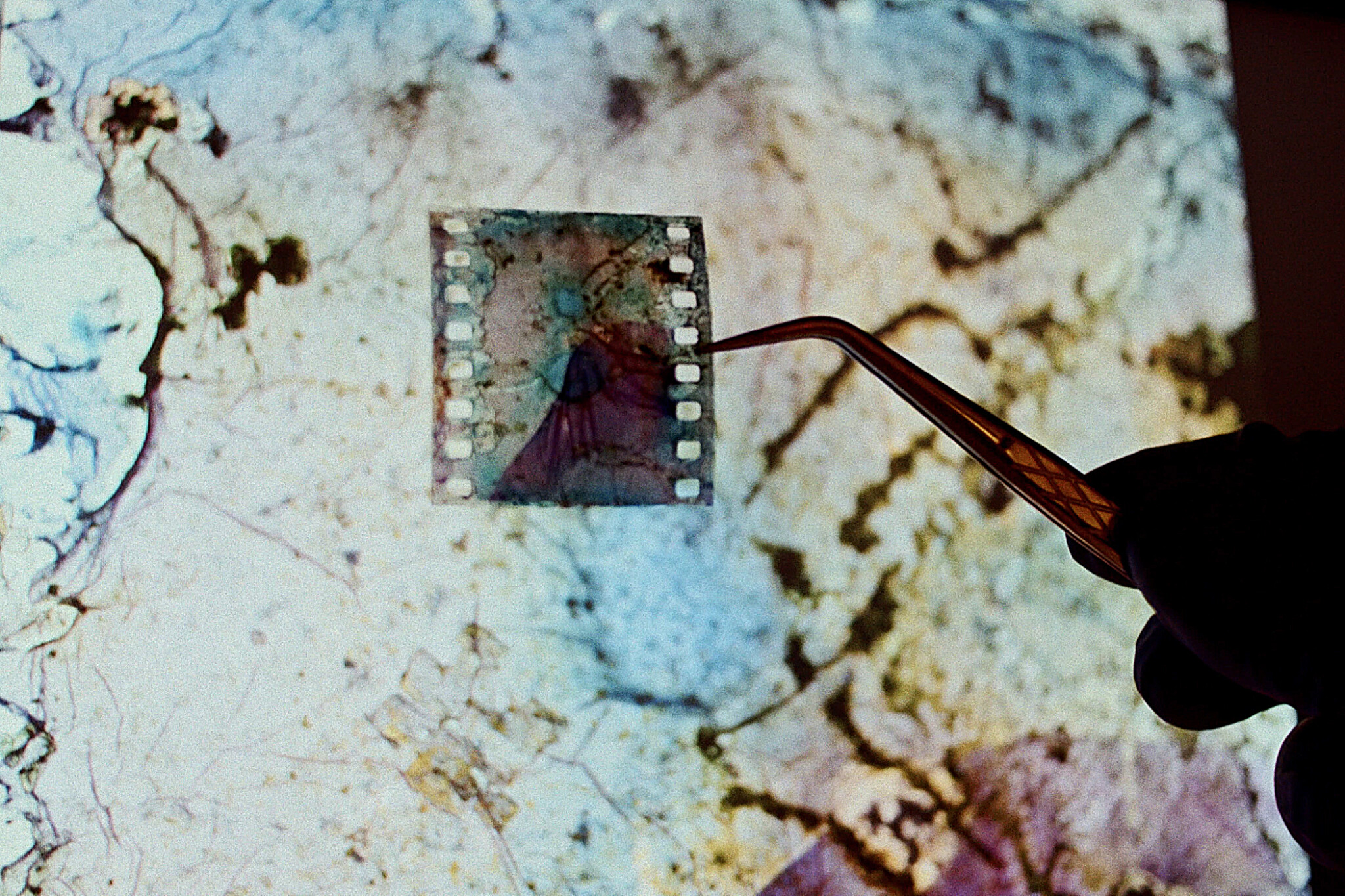

Be First to Comment